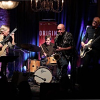Home » Jazz Articles » Album Review » Scenes: Variable Clouds: Live at the Earshot Jazz Festival
Scenes: Variable Clouds: Live at the Earshot Jazz Festival
The listener may wonder that after thirty years, what more could this post-bop gathering of four actually have to say that would be enlightening and fresh to listeners? What could an eighth release on the Origin Records label possibly add to the band's already impressive legacy? The simple answer to that is, "Plenty."
Variable Clouds: Live at the Earshot Jazz Festival is "living" proof of that. From the outset, the recording being performed before a live audience at the 2021 Earshot Jazz Festival in Seattle presents a case for exception. After all, this was shortly after the world returned to live music after more than two years of pandemic isolation. Still, being that jazz albums, and most certainly Scenes albums, are recorded live in the studio, how much does two hundred souls in the basement of the city's Town Hall add to the collective energy of the performance? The simple answer once again is, "Plenty."
There is a definitive arc to individual performances, with the high point occurring sometime after the downbeat in one, explosive moment between all participants. Careers can often arc in the same way with musicians, a concept apparently unfamiliar to the members of Scenes. While the musicianship has always been exquisite, that level of virtuosity has been aided in modern times by the collective intelligence gathered by the band over the years, extracted by each individual performer. Johnson and Bishop have been a notable pairing for three decades, most notably by being two-thirds of the groundbreaking rubato trio led by pianist Hal Galper. Stowell has become a player of international renown, possessing the unique ability to blend his often ethereal style with power players such as tenor player Michael Zilber. Mandyck, for his part, became both a fine jazz pianist and guitarist in the interim, attempting to recover from physical ailments that prevented him from playing saxophone. Upon returning, first on alto and then back to tenor, he has not only regained his trademark tonality and probing, melodic playing, he has ascended to the peak of his performance arc by adding the element of fearlessness, of knowing and appreciating the moment now more than ever.
The curious thing about Scenes is the marked difference between Mandyck and Stowell. Having doubts of the two merging creatively, and more so, of Stowell providing the harmonic foundation for Mandyck's compositions would be quite understandable. Yet, in listening to the opener "Tilbury Hill," and the title track, one finds the coupling to be musically and aesthetically pleasing. On the latter, Johnson's dark bow work and contemplative pizzicato blends with Bishop's brushwork to provide a layered canvas for Stowell and Mandyck to melodically interact. The former is a more straight ahead, with Stowell comping sparingly, providing harmonic context to Mandyck's beautiful melody and spontaneous assertions.
Johnson's contributions are true to his writing style that favors openness, as journeying through a thick forest and breaking out into a wide open space. "Studio City" begins with the bassist opening in a solo that includes gorgeous vibrato decorated lines, and crunching chordal insertions. Once again it is Bishop's precision work and Stowell's sparse yet orchestral comping that brings flight to the piece. Solo work by the guitarist and Mandyck's soaring tenor brings a sonic component to the tune that allows it to unleash any notion of repose.
Mandyck's tender rendition of the Rodgers/Hart classic, "It's Easy to Remember'' is easily the most memorable of the nine tunes presented on the recording, if only for the tenorist's masterful tone, reflective interpretation of the melody and overall sense of melancholy. Mandyck's ability to express the emotion of a ballad has always been novel, in this case, reflecting the tenderness of the tune's lyrics, or better yet, understanding the oneness of the melody and the lyrical narrative.
Stowell's "When Jasper Grows Up" finds the guitarist and Mandyck sharing the melody initially. Stowell's solo is performed in his definitive style, blending colorful, melodic passages with the harmony always present in the form of his lush chord work, choosing tastefully where and when to add it into his reworking of the melody.
Variable Clouds: Live at the Earshot Jazz Festival is more than just another celebration of leaving the cold isolation of lockdown behind. It is a gathering of four musical minds, of four long time friends, still ascending to their collective, creative arc, with no notion of sliding comfortably down the back side of the arc of their existence as a band. It is their most honest, most satisfying offering to date.
Track Listing
Tilbury Hill; Trudge; When Jasper Grows Up; Companions; Lonely Blue Angel; Variable Clouds; It's Easy to Remember; Studio City; Witchi Tai To.
Personnel
Album information
Title: Variable Clouds: Live at the Earshot Jazz Festival | Year Released: 2022 | Record Label: Origin Records
< Previous
Skopje Jazz Festival 2022
Next >
Art Of The Alto
Comments
About Scenes
Instrument: Band / ensemble / orchestra
Related Articles | Concerts | Albums | Photos | Similar ToTags
For the Love of Jazz
 All About Jazz has been a pillar of jazz since 1995, championing it as an art form and, more importantly, supporting the musicians who create it. Our enduring commitment has made "AAJ" one of the most culturally important websites of its kind, read by hundreds of thousands of fans, musicians and industry figures every month.
All About Jazz has been a pillar of jazz since 1995, championing it as an art form and, more importantly, supporting the musicians who create it. Our enduring commitment has made "AAJ" one of the most culturally important websites of its kind, read by hundreds of thousands of fans, musicians and industry figures every month.
























